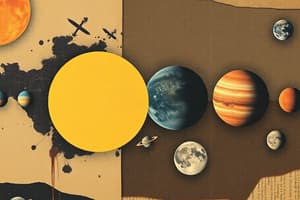Podcast
Questions and Answers
Which planets are classified as terrestrial?
Which planets are classified as terrestrial?
- Mercury, Venus, Earth and Mars (correct)
- Mercury, Earth, Jupiter and Neptune
- Jupiter, Saturn, Uranus and Neptune
- Mars, Jupiter, Earth and Saturn
Which planets are classified as Jovian?
Which planets are classified as Jovian?
- Jupiter, Saturn, Uranus and Neptune (correct)
- Mars, Jupiter, Earth and Saturn
- Mercury, Earth, Jupiter and Neptune
- Mercury, Venus, Earth and Mars
What is the order of the nine planets from closest to the sun to furthest from the sun?
What is the order of the nine planets from closest to the sun to furthest from the sun?
Mercury, Venus, Earth, Mars, Jupiter, Saturn, Uranus, Neptune
Jovian planets are rocky.
Jovian planets are rocky.
Terrestrial planets are gas.
Terrestrial planets are gas.
What is a Nebula?
What is a Nebula?
How did the distance from the sun affect the size and composition of the planets?
How did the distance from the sun affect the size and composition of the planets?
Flashcards are hidden until you start studying
Study Notes
Terrestrial and Jovian Planets
- Terrestrial planets include Mercury, Venus, Earth, and Mars; they are characterized by rocky compositions.
- Jovian planets are composed mainly of gas and consist of Jupiter, Saturn, Uranus, and Neptune.
Solar System Order
- The order of the planets from closest to the sun to the furthest is: Mercury, Venus, Earth, Mars, Jupiter, Saturn, Uranus, Neptune.
Characteristics of Planets
- Jovian planets are not rocky but are predominantly gas, distinguishing them from terrestrial planets.
- Terrestrial planets are solid and rocky in nature, contrasting with the gaseous composition of Jovian planets.
Nebula
- A nebula is defined as a cloud of dust and gas in space, serving as a nursery for new stars and planetary systems.
Influence of Sun on Planet Formation
- Proximity to the sun in the inner solar system resulted in high temperatures, allowing only metals and silicate minerals to solidify, leading to the formation of rocky terrestrial planets.
- In the colder outer solar system, gases and ices could condense, enabling the formation of gas giants or Jovian planets.
Studying That Suits You
Use AI to generate personalized quizzes and flashcards to suit your learning preferences.




